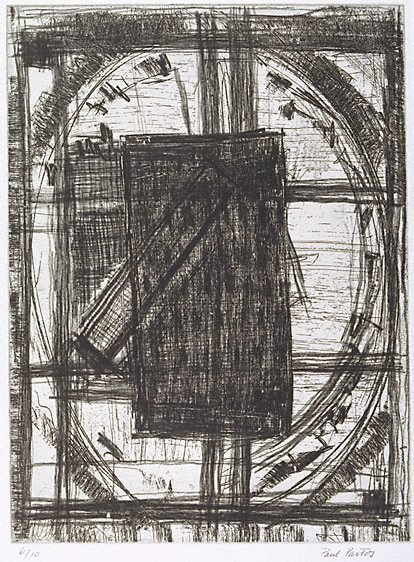-
Details
- Date
- 1986
- Media category
- Painting
- Materials used
- oil on canvas
- Dimensions
- 212.8 x 197.5 cm stretcher; 214.8 x 200.0 x 3.5 cm frame
- Signature & date
Not signed. Not dated.
- Credit
- Purchased 1987
- Location
- Not on display
- Accession number
- 6.1987
- Copyright
- © Estate of Paul Partos
- Artist information
-
Paul Partos
Works in the collection
- Share
-
-
About
These paintings illustrate the major phases in the evolution of the work of Paul Partos, one of Australia’s most resolute abstract artists. His early work consisted of abstracted figure paintings before he moved to total abstraction in time to be represented at 'The field' exhibition of 1968, which announced the emergence of the international style of colour field painting in Australia.
Painted soon after this exhibition, ‘Vesta II’ 1968 (AGNSW collection) typifies Partos’ approach: a strong geometry as the basis for the composition, a central ‘image’ (in this case a cut-out), thin flat paint, free of brushstrokes. The area surrounding the cut-out is divided into alternating dark and light quadrants, each with a soft rainbow-like gradient of colours. Vesta was the Roman goddess of the hearth, and until recently a brand that made the name synonymous with matches in Britain and Australia. The open centre and surrounding aura as well as the flickering dark/light quartering may have suggested the title.
In the next decade Partos abandoned his pure hard-edged style and synthetic polymer paint in favour of oils that allowed him to create different textures and initiate his characteristic use of impasto. ‘Kinship’, with its suffuse colours, crusty surface and expressionist approach typifies Partos’ mature work. By the 1980s he had become known for such lyrical paintings using pale scumbled tones to convey a weather-worn and poetic ambiguity. While the solid underpinning of the grid and central ‘image’ is maintained, albeit in a vestigial form, 'Kinship' is a celebration of paint rather than form.
The structure and motifs of earlier work are preserved in ‘Untitled (black-grey)’ 1990 (AGNSW collection) with variations: division into areas based on the grid, a central area of interest, play of paint treatment, thick or thin areas, contrasts of colour, soft and hard edges. This work, however, has an autobiographical aspect, referring to Partos’ childhood in the 1950s as a Czech migrant at the Clontarf Boys Town in Perth. Like clamps holding the painting to the wall, four small black squares visually anchor the corners. In the same vein, the black rectangle, complete with traces of a lesson, suggests a blackboard. Some paintings, for example ‘Pilgrimage I’ 1989–91, have letters scattered across the board. ‘Untitled (black-grey)’ is inscribed with lines ambiguously reminiscent of a trigonometry lesson or a naïve picture in chalk, standing perhaps as a link with his beginnings and as a metaphor for his own art.
© Art Gallery of New South Wales Contemporary Collection Handbook, 2006
-
Exhibition history
Shown in 1 exhibition
Surface for Reflection (1987), Art Gallery of New South Wales, Sydney, 22 Jan 1987–22 Feb 1987
-
Bibliography
Referenced in 2 publications
-
Michael Desmond, Contemporary: Art Gallery of New South Wales Contemporary Collection, 'Abstraction', pg.16-59, Sydney, 2006, 52 (colour illus.).
-
Charles Green, Fieldwork: Australian art 1968-2002, 'The discursive field: home is where the heart is', pg. 12-15, Melbourne, 2002, 14 (illus.), 25 (colour illus.). Illustration on pg. 14 shows installation photograph of entrance to 'The Field' exhibition, 1968, with Paul Partos' 'Vesta II' in the background.
-




